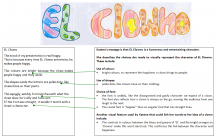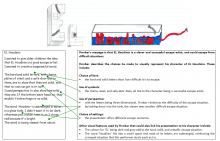El Flamo
This task is about sharing ideas and meaning using images.

Part 1
The purpose of this task is to identify and describe how visual techniques add meaning to a poem. Read the poem, look at the illustration, and read the definitions in the box below to help you answer the questions.
| A trouper is a performer.A ventriloquist is a person who can speak without moving their lips, and entertains people by making their words seem to be spoken by a puppet that they hold. |
a) Where is the poem set?
b) What are the two main purposes of this piece of writing?
c) The poem gives two facts that tell us what El Flamo does in his act. What are these two facts?
d) The picture suggests other clues about the performer El Flamo. An example has been given in the box below. Add three more examples.
| What the picture suggests about El Flamo | What gives me this clue |
| He impresses ladies | The ladies are focussed on him/looking at him |
|
|
|
|
|
e) Look at the symbol beside El Flamo's name in the poem. Describe one way you think this symbol has something to do with El Flamo.
Part 2
The purpose of this task is to communicate ideas visually and explain how you have done this. Your task is to:
-
Choose one of the following names for circus performers, or make up your own.

- Think of the colours, shapes, and objects that would go with this performer.
- Think of the font and layout that would best show what this performer does.
- Use the following table to help you plan the design of the name of your circus performer. Your presentation of their name must show what that performer is like and what they do.
Which performer have you chosen?
| Write down the words or ideas that come to mind when you think about this performer. | Plan which visual techniques you could use to show your ideas of this performer. | When you have finished, explain how your visual techniques communicate ideas about your circus performer. |
|
|
||
|
Feedback from someone in your class
Impact: How well do the visual techniques communicate ideas about the performer?
Concept: How clear are the written explanations of the visual techniques?
What other ideas are shown in the presentation, and how you would explain them:
Signed: __________________________________
|
||




